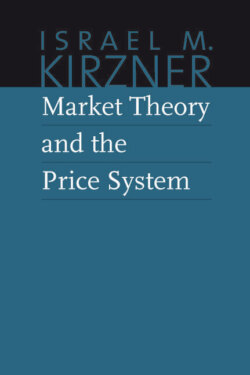Читать книгу Market Theory and the Price System - Israel M. Kirzner - Страница 23
На сайте Литреса книга снята с продажи.
THE STRUCTURE OF THE MARKET SYSTEM: VERTICAL RELATIONSHIPS
ОглавлениеThe analytical isolation of the various possible market roles leads directly to the perception of a unique structure of human actions within the market system. The recognition of market structure is in turn the indispensable step toward the understanding of market operation.
In asserting that there is a structure in the decisions made in the marketplace, we mean simply that the decisions belonging to each of the various market roles are linked in a stable pattern of relationships. Decisions of resource owners, for example, are conditioned on the one hand by the urge to gain money income, and on the other hand by the different alternatives offered by various entrepreneurs. The decisions of consumers are conditioned on the one hand by their own tastes and income, and on the other hand by the different alternatives offered to them by various entrepreneurs. The decisions of the entrepreneur, in turn, are conditioned by a simultaneous appraisal of the various alternatives offered to him by those he is able to buy from, and of the various alternatives offered to him by those he may be able to sell to; and so on.
In this section we notice, first of all, markets related to each other “vertically.” A vertical relationship can be said to exist between two markets when goods or services bought in one of the markets are sold (either alone or in combination with other goods or services) in the other market. The simplest possible notion of vertical structure within the market system may perhaps be obtained from Figure 2-1. The figure shows here that the market system consists of two markets; a market for products (in which entrepreneurs are the sellers and consumers are the buyers), and a market for productive services (in which resource owners are the sellers, and entrepreneurs are the buyers).3 The structural relationship between the markets is seen, for example, by noticing that the prices consumers are willing to pay for particular products in the product market will determine the prices entrepreneurs can offer for particular resources in the market for productive services (also termed the resource market or the factor market).
Figure 2-1
A more realistic view of the vertical structure of a typical market system would recognize that the activities of the entrepreneur may result in the production not only of goods for the consumer, but also of produced goods that can provide productive services with which other producers may produce goods or services for the consumers. The Austrian economist Menger introduced the concept of the “order” of a good to express this kind of complexity. A good demanded for consumption is a good of “lowest order.” The goods required for the production of goods of lowest order are goods of second order, those required for the production of second order goods are the third order goods, and so on. The point is that entrepreneurial activity will be possible wherever there are two “vertically adjacent” markets; one market for a particular good, and another market in the goods of higher order with which the particular good can be produced. The complex vertical structure of a developed market system can now be glimpsed more fully. There are not merely the two markets whose relationship is indicated in Figure 2-1; there are likely to be numberless markets related vertically to each other in such a way. Between each pair of adjacent markets, there will be entrepreneurial activity. The entrepreneur will buy in the one market, produce, and sell in the market “below” it. (Here again, incidentally, the entrepreneurial role is closely integrated with that of resource owner. The initial decision to buy and sell in the different markets is an entrepreneurial one; but once the entrepreneurial decision has been made, and the good of higher order has been produced, the entrepreneur finds himself selling in the “lower” market just as any other resource owner.)
Moreover, although the vertical relationship between two markets may appear to stamp one of them as being “higher” than the other, there may be some other equally valid point of view from which the order of relationship is reversed. For example, iron ore is used in the production of steel which in turn is used in the production of equipment which plays a part in the mining of iron ore. The decisions of entrepreneurs buying iron ore in order to produce steel will be influenced in part by the decisions of those to whom they sell; that is, the entrepreneurs engaged in the production of mining equipment. But these latter decisions will clearly be partly influenced by the decisions of those buying this equipment—the miners of iron ore.
There are certainly strands of a vertical relationship existing between the market for iron ore, and the market for mining equipment, where the latter market is the higher; but there are, no less clearly, other strands of a vertical relationship between the two markets where the market for iron ore is the higher.
